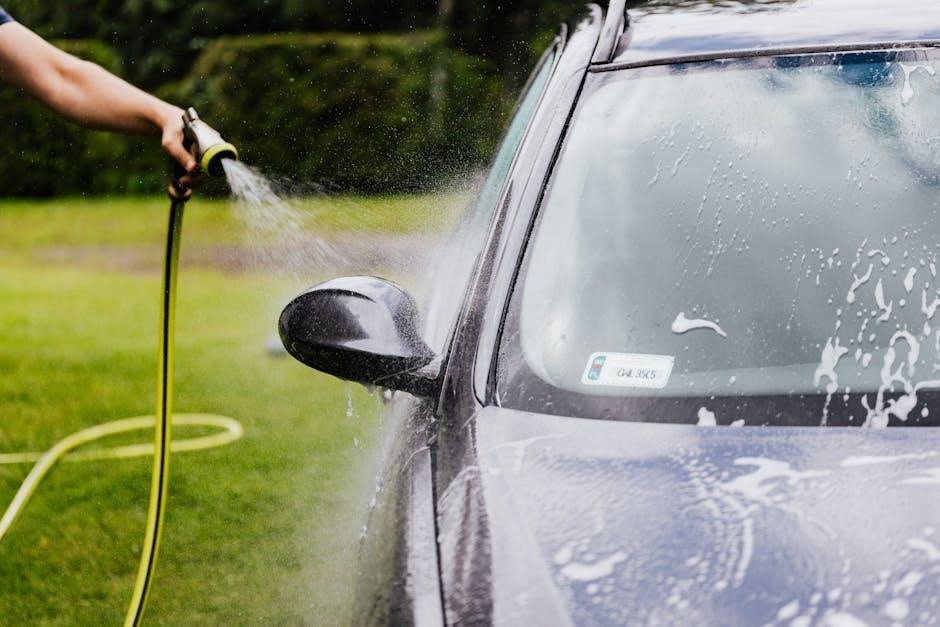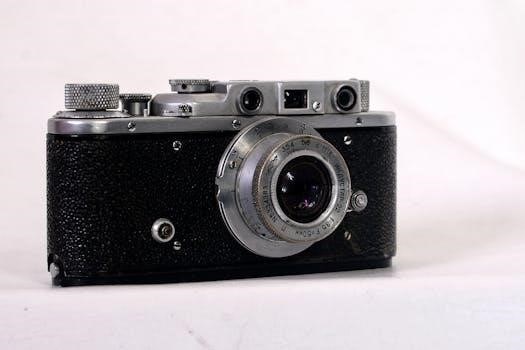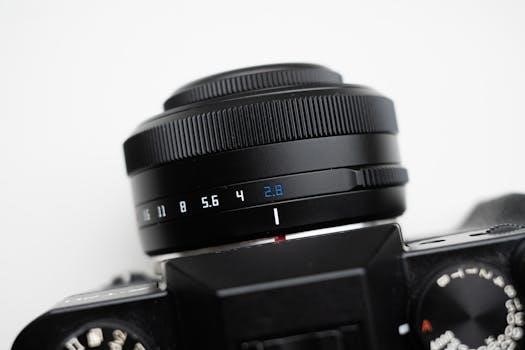The Chamberlain RJ070 manual provides a comprehensive guide to installing and operating this advanced wall-mounted garage door opener. It features smart technology‚ compatibility with the MyQ app‚ and quiet operation‚ ensuring seamless integration into modern homes while saving space with its sleek design.
1.1 Overview of the Chamberlain RJ070 Garage Door Opener
The Chamberlain RJ070 is a wall-mounted garage door opener designed for modern homes‚ offering a sleek‚ space-saving solution. It features advanced smart technology‚ compatibility with the MyQ app‚ and whisper-quiet operation. Part of the Chamberlain Group‚ which includes LiftMaster and myQ‚ this opener combines reliability with innovative features. The RJ070 is ideal for homeowners seeking a compact‚ high-performance system that integrates seamlessly with smart home systems. Its design ensures minimal visual impact while providing robust functionality‚ making it a popular choice for those looking to enhance their garage’s convenience and security.
1.2 Key Features of the RJ070 Model
The RJ070 model stands out with its wall-mounted design‚ saving valuable garage space while offering advanced functionality. It features smart home compatibility‚ enabling control through the MyQ app for remote monitoring and operation. The opener boasts whisper-quiet operation‚ making it ideal for homes where noise is a concern. Safety is prioritized with the Protector System‚ ensuring the door’s safe operation and cable tension. Additionally‚ it includes tamper-resistant features and child safety locks for enhanced security. The RJ070 is designed for seamless integration with modern smart home systems‚ providing a convenient and secure garage door solution.
1.3 Compatibility with Smart Home Systems

The Chamberlain RJ070 is designed to seamlessly integrate with smart home systems‚ offering enhanced convenience and security. It is fully compatible with the MyQ app‚ allowing users to monitor and control their garage door remotely. This feature enables real-time notifications and the ability to operate the door from anywhere. The RJ070 also works with popular smart home platforms like Apple HomeKit and Google Assistant‚ providing voice command functionality. This integration ensures that the opener can be controlled alongside other smart devices‚ creating a unified and modern home automation experience. The RJ070’s smart compatibility makes it an ideal choice for homeowners looking to upgrade their garage door system.
Installation Requirements and Preparation
Ensure a strong WIFI signal and install a 20-amp GFI-protected outlet. Properly balance the garage door‚ a complex task requiring precise tools and expertise‚ suggesting professional assistance if unsure.
2.1 Pre-Installation Checklist
Before starting‚ ensure a strong WIFI signal and install a 20-amp GFI-protected outlet. Verify the garage door is balanced‚ as improper alignment can hinder operation. If unsure‚ consider professional assistance for balancing. Check the Protector System and cable tension to ensure safety features function correctly. Gather all components and tools from the package. Review the manual to confirm compatibility with your garage door type and size. Ensure the area is clear of obstacles for smooth installation. Double-check the opener’s compatibility with your router specifications‚ available at support.chamberlaingroup.com. Proper preparation ensures a safe and efficient installation process.
2.2 Tools and Materials Needed
To install the Chamberlain RJ070‚ gather essential tools and materials. A ladder‚ wrench‚ screwdrivers‚ and a drill are necessary for mounting and wiring. Ensure you have a 20-amp GFI-protected outlet installed. The opener includes a hub that connects to your WIFI‚ so a strong router signal is crucial. Check the package for all components‚ including the rail assembly‚ motor‚ and sensors. Additional materials like screws‚ brackets‚ and cables may be required. Safety gear‚ such as gloves and goggles‚ is recommended. Refer to the manual for a detailed inventory list to ensure nothing is missing before starting the installation process.
2.3 Garage Door Balance and Safety Checks
Before installing the Chamberlain RJ070‚ ensure your garage door is properly balanced and safe to operate. A balanced door is essential for smooth function and to prevent damage to the opener. Disconnect the door from the current opener and test its weight by lifting it manually. If it doesn’t stay in place or feels uneven‚ adjust the springs or consult a professional. Inspect the door tracks‚ rollers‚ and springs for wear or damage. Ensure the Protector System and cable tension are correctly set to avoid accidents. Improper balance or safety issues can lead to malfunction or injury‚ so address these before proceeding with installation.
Step-by-Step Installation Guide

The Chamberlain RJ070 manual offers a detailed‚ step-by-step guide for installing the wall-mounted opener‚ ensuring proper Wi-Fi setup and a balanced garage door for smooth operation.
3.1 Unpacking and Inventory of Components
Begin by carefully unpacking the Chamberlain RJ070 components‚ ensuring all parts are included. The package typically contains the opener unit‚ rail assembly‚ mounting hardware‚ remote controls‚ and the manual. Verify each item against the inventory list to avoid missing parts. Pay special attention to the opener’s hub‚ which may be integrated into the unit or light‚ and ensure the Wi-Fi adapter is included for smart connectivity. Organize the components neatly to streamline the installation process. Refer to the manual for a detailed list and descriptions of each part. This step is crucial for a smooth and successful installation experience.
3.2 Mounting the Opener and Rail Assembly
Mounting the Chamberlain RJ070 opener and rail assembly requires careful planning and precision. Begin by locating the center of your garage door and marking the wall for the opener’s bracket. Ensure the surface is level and sturdy to support the unit’s weight. Attach the mounting bracket securely‚ following the manual’s instructions. Next‚ align the rail assembly with the opener and connect it firmly. Double-check all bolts and screws for tightness. If you’re unsure about the installation‚ consider hiring a professional‚ especially if your garage door is heavy or unbalanced. Proper mounting ensures smooth operation and safety‚ so take your time to get it right.
3.3 Wiring and Electrical Connections
Proper wiring and electrical connections are crucial for the Chamberlain RJ070’s operation. Ensure a dedicated 20-amp GFI-protected outlet is installed near the opener. Connect the opener to the hub‚ which is typically integrated into the light or opener unit. A strong WIFI signal from your router is essential for smart features. Carefully follow the manual to connect all wires‚ ensuring no loose connections. If unsure‚ consult a licensed electrician to avoid safety hazards. After wiring‚ test the system to confirm everything functions correctly. Proper electrical setup ensures reliable performance and seamless integration with smart home systems.
3.4 Final Assembly and Alignment
After mounting and wiring‚ the final assembly involves attaching all components securely. Ensure the rail is properly aligned with the garage door‚ and all brackets are tightly fastened. Double-check the trolley’s connection to the motor and the door arm’s attachment to the garage door. Align the safety sensors correctly to ensure they are parallel and unobstructed. Test the opener by operating it manually and through the remote to confirm smooth movement. If the door jerks or stops unevenly‚ adjust the travel limits and force settings as outlined in the manual. Proper alignment ensures safe and reliable operation‚ preventing potential damage or safety hazards.

Programming and Configuration

Program the remote‚ keypad‚ and MyQ app for seamless control. Adjust travel limits‚ force settings‚ and sensor alignment to ensure smooth‚ safe operation of your garage door opener.
4.1 Programming the Remote Control
Programming the remote control for your Chamberlain RJ070 is a straightforward process. Start by locating the yellow “Learn” button on the opener. Press and hold it until the LED light blinks‚ indicating it is in programming mode. Next‚ press the desired button on your remote control. The opener will confirm the pairing by blinking the LED or clicking. Test the remote to ensure it works properly. If issues arise‚ repeat the process or consult the manual. This ensures secure and reliable operation of your garage door opener. Proper alignment of the Protector System is also essential for smooth functionality.
4.2 Setting Up the Keypad
Setting up the keypad for your Chamberlain RJ070 involves a few simple steps. First‚ locate the yellow “Learn” button on the opener and press it until the LED blinks. Enter your desired PIN on the keypad‚ followed by the “Enter” button. The opener will confirm the setup with a blink or click. Test the keypad to ensure it operates the door correctly. For added security‚ ensure the Protector System is properly aligned. This process allows for keyless entry and convenient access. Refer to the manual for troubleshooting tips if issues arise during setup. Proper installation ensures smooth and secure operation.
4.3 Adjusting Travel Limits and Force Settings
Adjusting travel limits and force settings on the Chamberlain RJ070 ensures smooth and safe operation. Press and hold the “Learn” button until the LED blinks‚ then use the remote to set the door’s open and close positions. For force settings‚ test the door’s resistance and adjust the screws until it moves effortlessly. Proper alignment of the Protector System is crucial for safety. If issues arise‚ consult the manual for troubleshooting steps. These adjustments ensure the opener operates efficiently and safely‚ preventing damage to the door or opener. Regular checks are recommended to maintain optimal performance and security.
4.4 Sensor Alignment and Safety Features
Proper sensor alignment is critical for the Chamberlain RJ070’s safety features to function correctly. The sensors‚ located near the floor‚ must be aligned to ensure the door detects obstacles. If misaligned‚ the door may not close properly or could cause accidents. To align‚ adjust the sensors until the green LEDs light steadily. The Protector System‚ including the safety sensors and cable tension‚ prevents accidents by reversing the door if an obstruction is detected; Regularly check and clean the sensors to maintain reliability. Misaligned sensors can disable safety features‚ so ensure they are securely fastened and properly aimed. Always test the door’s operation after adjustments.

Maintenance and Troubleshooting
Regular maintenance ensures optimal performance. Clean sensors‚ lubricate moving parts‚ and check cable tension. Troubleshoot common issues like misalignment or sensor malfunctions promptly to avoid operational disruptions.
5.1 Routine Maintenance Tips
Regular maintenance is crucial for the Chamberlain RJ070’s optimal performance. Clean the sensors and rails periodically to ensure smooth operation. Lubricate moving parts every six months to reduce friction and noise. Check the cable tension and adjust if necessary to maintain safety and efficiency. Ensure the garage door is balanced to prevent strain on the motor. Inspect the opener’s electrical connections and wiring for any damage or wear. Additionally‚ verify that the WIFI signal is strong and stable for reliable smart home integration. Refer to the manual or Chamberlain’s online resources for detailed guidance on these procedures.
5.2 Common Issues and Solutions
Common issues with the Chamberlain RJ070 include sensor misalignment‚ door imbalance‚ and WIFI connectivity problems. For sensor issues‚ ensure they are clean and properly aligned. If the door doesn’t close‚ check the Protector System and cable tension. Connectivity problems can be resolved by restarting the router or ensuring a strong WIFI signal. If the opener is unresponsive‚ verify electrical connections and circuit breaker status. For persistent issues‚ refer to the manual or Chamberlain’s technical support resources. Regular maintenance‚ such as lubricating moving parts‚ can prevent many of these problems. Always follow safety guidelines when troubleshooting to avoid accidents.
5.3 Lubrication and Parts Replacement
Regular lubrication of moving parts‚ such as rollers and springs‚ is essential for smooth operation. Use a silicone-based lubricant to maintain optimal performance. Inspect and replace worn or damaged parts promptly to prevent malfunctions. Common replacements include rollers‚ springs‚ and sensors. Always refer to the manual for specific instructions and compatible parts. Lubricate the rail assembly annually to ensure quiet and efficient operation. Replace the battery in remote controls every 2-3 years or as needed. Proper maintenance extends the lifespan of the opener and ensures safety. Dispose of replaced parts responsibly and follow safety guidelines during replacement to avoid accidents.

Advanced Features and Customization
The RJ070 offers smart home integration via the MyQ app‚ enabling remote monitoring and control. Customize settings for optimal performance‚ ensuring seamless operation tailored to your needs.
6.1 Smart Home Integration
The Chamberlain RJ070 seamlessly integrates with smart home systems‚ offering advanced connectivity through the MyQ app. This allows users to monitor and control their garage door remotely‚ ensuring convenience and security. Compatible with popular platforms like Apple HomeKit and Google Home‚ the RJ070 enables voice command functionality and effortless automation. The opener’s hub is built into the unit‚ requiring only a strong WIFI signal for operation. This feature-rich integration enhances home automation‚ providing real-time notifications and customizable settings. With the MyQ app‚ users can grant access to guests‚ monitor door status‚ and receive alerts for any unauthorized access‚ ensuring peace of mind.
6.2 Customizing Settings for Optimal Performance
Customizing the Chamberlain RJ070’s settings ensures optimal performance tailored to your garage door and usage preferences. Adjust travel limits to define the door’s open and close positions precisely. Fine-tune force settings to accommodate the door’s weight and material‚ ensuring smooth operation. Sensor alignment can also be customized to enhance safety features‚ such as the Protector System. The MyQ app allows users to adjust these settings remotely‚ while physical buttons on the opener provide direct access. Regularly testing and refining these settings guarantees reliable and efficient operation. Customization options empower users to maximize the opener’s functionality‚ ensuring it works seamlessly with their specific garage door setup and preferences.
6.3 Using the MyQ App for Remote Control
The MyQ app enables seamless remote control of the Chamberlain RJ070‚ allowing users to monitor and operate their garage door from anywhere. With real-time notifications‚ you’ll always know if your door is open or closed. The app simplifies setup and provides intuitive controls for opening‚ closing‚ or checking the door’s status. It also integrates with smart home systems‚ offering voice command functionality. For enhanced convenience‚ users can schedule door operations or grant temporary access to guests. The MyQ app ensures you’re always in control‚ providing peace of mind and added security for your home. Regular updates keep the app feature-rich and user-friendly.
Safety and Security Features
The Chamberlain RJ070 includes advanced safety features like the Protector System‚ ensuring safe operation and preventing accidents. It also offers emergency release for manual control during power outages‚ enhancing security and convenience.
7.1 The Protector System and Cable Tension
The Chamberlain RJ070 manual emphasizes the importance of the Protector System‚ which ensures safe and reliable operation. Proper cable tension is critical to prevent accidents and maintain smooth functionality. The system must be correctly aligned and tensioned during installation‚ as specified in the manual. If the Protector System is not properly set up‚ the garage door may not close or function safely. The manual also highlights the need to fasten it securely near the garage door for easy reference. This ensures that users can quickly verify proper installation and operation‚ adhering to safety guidelines for optimal performance and security.
7.2 Emergency Release and Manual Operation
The Chamberlain RJ070 manual details the emergency release mechanism‚ allowing manual operation during power outages or system malfunctions. This feature ensures users can open or close the garage door safely. To engage manual mode‚ the red emergency release cord must be pulled‚ disengaging the opener from the door. The manual emphasizes the importance of ensuring the door is properly balanced before manual operation to avoid injury or damage. This feature provides peace of mind‚ knowing the garage door can be controlled even when the opener is not functioning. Regular checks of the emergency release mechanism are recommended to ensure reliability and safety.
7.3 Child Safety and Tamper-Resistant Features
The Chamberlain RJ070 manual highlights advanced child safety features‚ including the Protector System‚ which automatically reverses the door if an obstacle is detected. Tamper-resistant components prevent unauthorized access‚ ensuring the system remains secure. The manual emphasizes proper sensor alignment to maintain safety functions. Additional guidelines are provided to prevent accidental operation‚ such as keeping remotes out of children’s reach. These features are designed to protect families while maintaining reliable performance. Regular checks of safety mechanisms are recommended to ensure optimal functionality and peace of mind for homeowners with children.

Technical Specifications and Compatibility
The Chamberlain RJ070 features a powerful DC motor‚ ensuring quiet and smooth operation. It is compatible with most garage door types and integrates seamlessly with smart home systems via WIFI connectivity for enhanced control through the MyQ app‚ offering remote monitoring and operation. The opener requires a 20-amp GFI-protected outlet for reliable performance‚ making it a versatile choice for modern homes seeking advanced functionality and compatibility.
8.1 Motor Power and Speed
The Chamberlain RJ070 is equipped with a powerful DC motor‚ designed for smooth and quiet operation. While the exact horsepower isn’t specified‚ the motor delivers consistent performance‚ ensuring quick and controlled movement of the garage door. Its speed is optimized for efficient opening and closing‚ making it suitable for daily use. The motor’s design minimizes noise‚ making it ideal for homes where quiet operation is a priority. Additionally‚ the RJ070 is compatible with a wide range of garage door types‚ including insulated and heavy-duty doors‚ ensuring versatility for various homeowner needs. The motor’s reliability and performance make it a standout feature of this model.
8.2 Noise Level and Operational Smoothness
The Chamberlain RJ070 is renowned for its ultra-quiet operation‚ making it ideal for homes where noise reduction is a priority. Its advanced DC motor and belt-drive system ensure smooth‚ whisper-quiet performance. The opener’s design minimizes vibrations and operational noise‚ providing a seamless experience. This feature is particularly beneficial in homes with living spaces adjacent to the garage. The RJ070’s operational smoothness is further enhanced by its precise engineering‚ allowing for consistent and reliable door movement. Whether opening or closing‚ the system operates with minimal disruption‚ making it a top choice for homeowners seeking both functionality and peace of mind.
8.3 Compatibility with Garage Door Types
The Chamberlain RJ070 is designed to work seamlessly with a variety of garage door types‚ including single and double doors. It is compatible with steel‚ wood‚ and vinyl doors‚ as well as insulated and non-insulated models. The opener’s universal design ensures it can handle doors of different weights and sizes‚ making it a versatile option for homeowners. Proper door balance is essential for optimal performance‚ and the RJ070 works efficiently with doors that meet standard safety and weight requirements. This compatibility makes it a reliable choice for modern garage setups‚ ensuring smooth operation across various door configurations and materials.

Warranty and Customer Support
The Chamberlain RJ070 comes with a comprehensive warranty and dedicated customer support. Technical assistance is available through online resources‚ videos‚ and direct contact with Chamberlain’s support team.
9.1 Warranty Information
The Chamberlain RJ070 manual outlines a comprehensive warranty program‚ ensuring customer satisfaction. The product is backed by a limited warranty covering parts and labor for a specified period. This warranty demonstrates Chamberlain’s commitment to quality and reliability. For detailed terms and conditions‚ users are advised to consult the manual or visit the official Chamberlain website. Proper installation and maintenance are required to uphold warranty validity. Customers can register their product online or contact Chamberlain’s support team for assistance with warranty-related inquiries. This ensures peace of mind and protection for investments in their garage door opener system.
9.2 Contacting Chamberlain Support
For assistance with the Chamberlain RJ070‚ customers can contact Chamberlain Support through various channels. Visit their official website for detailed support resources‚ including technical guides and troubleshooting tips. Phone support is available during extended hours‚ and live chat options are accessible online. Additionally‚ email support is provided for less urgent inquiries. The Chamberlain support team is trained to address installation‚ maintenance‚ and operational issues. Users can also access a comprehensive FAQ section and instructional videos on the website. Chamberlain’s commitment to customer service ensures prompt resolution of any concerns related to the RJ070 model‚ enhancing the overall user experience.
9.3 Online Resources and Community Forums
Chamberlain offers extensive online resources and community forums to support RJ070 users. The official Chamberlain website provides access to technical support‚ instructional videos‚ and downloadable manuals. Community forums allow users to share experiences‚ ask questions‚ and receive tips from experienced owners. These platforms are invaluable for troubleshooting common issues or optimizing the opener’s performance. Additionally‚ Chamberlain’s online portal offers FAQs‚ software updates‚ and compatibility guides. Engaging with these resources ensures users can resolve issues quickly and make the most of their RJ070 model. The combination of official support and community interaction creates a robust ecosystem for addressing any concerns effectively.
The Chamberlain RJ070 manual is an essential resource for installing and maintaining this advanced garage door opener. Its smart features‚ space-saving design‚ and compatibility with the MyQ app make it a top choice for modern homes‚ offering convenience‚ security‚ and reliability.
10.1 Summary of Key Points
The Chamberlain RJ070 manual offers detailed guidance for installation‚ operation‚ and maintenance of this advanced wall-mounted garage door opener. It emphasizes smart home integration‚ compatibility with the MyQ app‚ and a sleek‚ space-saving design. The manual covers essential steps for programming remotes‚ setting up keypads‚ and adjusting safety sensors. It also provides troubleshooting tips and maintenance routines to ensure optimal performance. With a focus on user convenience and security‚ the RJ070 manual is a comprehensive resource for homeowners seeking a reliable and modern garage door solution. Its clear instructions and advanced features make it a standout choice for smart home enthusiasts.

10.2 Benefits of the RJ070 Model
The RJ070 model offers numerous benefits‚ including its wall-mounted design‚ which saves garage space and provides a sleek‚ modern appearance. It operates quietly‚ making it ideal for homes where noise reduction is essential. The opener is fully compatible with smart home systems‚ allowing users to control and monitor their garage door remotely via the MyQ app. Enhanced safety features‚ such as the Protector System‚ ensure reliable operation and security. Additionally‚ the RJ070 is energy-efficient and designed for long-lasting performance. Its advanced technology and user-friendly interface make it a top choice for homeowners seeking convenience‚ security‚ and durability in a garage door opener.

































































